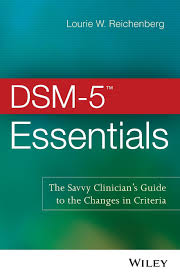ISBN: 978-1-118-84608-7
APA Style Citation
Reichenberg, L. (2014). DSM-5 Essentials: The Savvy Clinician's Guide to the Changes in Criteria. Hoboken, New Jersey: John Wiley and Sons.
| open_class_dsm_5.pdf |
The publication of the DSM-5 manual will change how mental illness and treatment are taught in psychology courses. This useful manual created a licensed professional counselor can be an invaluable resource for redesigning curriculum. Considering that the DSM-5 sells for over $100 and contains almost nine hundred pages, this handbook can provide instructors and students with a condensed summary at a fraction of the cost. This will enable instructors to quickly familiarize themselves and become up to date on the new classification systems. It also condenses the vast amount of material in the DSM-5 for ease of use. For example, obsessive compulsive disorder and posttraumatic stress disorder are no longer classified as anxiety disorders. Obsessive-compulsive disorder (OCD) now is part of a category called obsessive-compulsive and related disorders which also includes body dysmorphic disorder, hoarding disorder, trichotillomania, and excoriation. Posttraumatic stress disorder (PTSD) is now part of the category called trauma- and stressor-related disorders which also includes acute stress disorder, and adjustment disorders. These changes and the rationale behind many of them are described simply and succinctly.
The book also explains the new dimensional approach to diagnosis, which replaces the axis system used in prior versions of the DSM, which makes the manual more aligned with how the World Health Organization’s International Classification of Diseases organizes diagnoses. The new manual acknowledges that years of research indicated that many of the disorders in the DSM-IV were not in fact unique conditions, but simply a reflection of severity along a continuum. The spectrum approach for many disorders has been specifically added to the DSM-5 for many conditions including substance abuser, autism, and schizophrenia.
Reichenberg’s book includes the main disorders in each of the twenty classifications present in the DSM-5. For each disorder there is a short description of diagnostic criteria, symptoms, specifiers, and specific information regarding some of the changes to each disorder that occurred with the update to the manual. The author explains what the changes mean for diagnosis and how these changes impact how clinicians choose the most appropriate evidence based treatment for each condition. DSM-5 Essentials lists the categories and disorders in the same order as they appear in the DSM-5. The author explains that the DSM-5 presents disorders according to how they would likely appear throughout the lifespan. Thus, the first category listed is neurodevelopmental disorders, which are diagnosed early in life (e.g. intellectual disability, autism) and neurocognitive disorders (e.g. Alzheimer’s delirium), which appear towards the end.
The final chapter of the book addresses the emerging models, new assessments designed to help clarify diagnoses, methods to address cultural issues in clinical interviews, a potential alternative model of describing personality disorders, and several conditions which are recommended for further study. The eight conditions which need further study before being added to the manual are attenuated psychosis syndrome, depressive episodes with short-duration hypomania, persistent complex bereavement disorder, caffeine use disorder, internet gaming disorder, neurobehavioral disorder due to prenatal alcohol exposure (ND-PAE), nonsuicidal self-injury (NSSI), and suicidal behavior disorder. Each of these potential diagnoses is described briefly and could make an interesting classroom discussion.
Other Related Resources
American Psychiatric Association: highlights changes in the DSM-5.
http://www.dsm5.org/Documents/changes%20from%20dsm-iv-tr%20to%20dsm-5.pdf
One-page descriptions summarizing the criteria for common diagnoses under DSM-5 called fact sheets.
http://www.psychiatry.org/dsm5
Psychological Figures and Concepts
DSM-5
American Psychiatric Association
Neurodevelopmental disorders (e.g., attention deficient hyperactivity disorder, autism spectrum disorder, intellectual disability)
Schizophrenia spectrum and other psychotic disorders (e.g., schizotypal personality disorder, schizophrenia, schizoaffective disorder)
Bipolar and related disorders (e.g., bipolar I, bipolar II, cyclothymic disorder)
Depressive disorders (e.g., disruptive mood dysregulation disorder, major depressive disorder, persistent depressive disorder or dysthymia, premenstrual disorder)
Anxiety disorders (e.g., separation anxiety disorder, selective mutism, specific phobia, social anxiety disorder, panic disorder, agoraphobia)
Obsessive-compulsive related disorders (e.g., obsessive-compulsive disorder, body dysmorphic disorder, hoarding disorder, trichotillomania, excoriation)
Trauma- and stressor-related disorders (e.g., reactive attachment disorder, posttraumatic stress disorder, acute stress disorder, adjustment disorders)
Dissociative disorders (e.g., dissociative identity disorder, dissociative amnesia)
Somatic symptom and related disorders (e.g., somatic symptom disorder, illness anxiety disorder, functional neurological symptom disorder/conversion disorder, factitious disorder)
Feeding and eating disorders (e.g., pica and rumination disorder, avoidant/restrictive intake disorder, anorexia nervosa, bulimia disorder, binge-eating disorder)
Sleep-wake disorders (e.g., insomnia disorder, narcolepsy, sleep apnea, sleep terrors)
Disruptive, impulse control, and conduct disorders (e.g., oppositional defiant disorder, conduct disorder)
Substance-related and addictive disorders (e.g., substance use disorders, substance withdrawal, substance intoxication)
Neurocognitive disorders (e.g., delirium, major neurocognitive disorder, mild neurocognitive disorder)
Personality disorders

 RSS Feed
RSS Feed